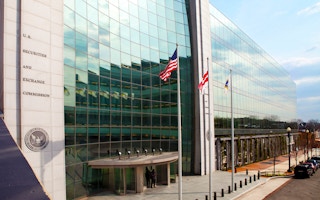I spend most days advocating for action that could be considered radical. But today, I am advocating for plain common sense. In March, the US Securities and Exchange Commission proposed a new rule that would require publicly traded companies to disclose their climate-related risks and greenhouse-gas (GHG) emissions. Now that the public comment period has ended, the SEC should adopt the new disclosure rule in its entirety.
As written, the proposed rule would require companies to disclose GHG emissions data for their own operations, as well as for the goods they buy and sell. It would apply to all companies publicly traded in the United States, and thus to the US$82 trillion worth of trading that the SEC oversees each year.
The rule may sound sweeping, but it is really just about information. Businesses should be required to share with investors how climate change could affect their returns. Information is the bread and butter of financial regulators, CEOs, investors, and markets generally. Each trade is connected to an investor making decisions based on the best available information. There is nothing radical about wanting more.
The SEC’s action comes at just the right time. Businesses bore a stiff share of the $145 billion in weather and climate-related costs incurred in the US in 2021. Climate risks are already substantial and can be expected to grow. That’s why a bipartisan, business-heavy committee, which included the World Resources Institute, recommended new disclosure rules in a 2020 report to the Commodity Futures Trading Commission.
How climate change affects business is exactly the sort of information that CEOs need to manage risks and take advantage of new opportunities. Investors and governments around the world are increasingly pushing for greater information transparency. The G20-backed Task Force on Climate-Related Financial Disclosures (TCFD) issued its recommendations back in 2017, garnering the support of more than 3,000 companies and 92 countries around the world since then.
Moreover, the International Sustainability Standards Board expects to issue new climate-related rules by the end of the year. China is testing a mandatory disclosure policy. The United Kingdom is phasing in TCFD-style mandatory disclosure rules over the next three years. And the European Union is working out its Sustainable Finance Taxonomy, which goes further than climate-risk disclosure by categorising economic activity according to clear sustainability criteria. All these initiatives will require corporate GHG-emissions reporting.
For many business leaders, there’s nothing new here. Leading companies such as Apple, Best Buy, Coca-Cola, Cargill, Ford, Gap, Hilton, and Starbucks are already disclosing climate-related risks, including those associated with their supply chains. Far from fringe, these companies represent mainstream America. Even the oil and gas giants Shell, TotalEnergies, and Equinor have a long track record of reporting on emissions across their value chains.
“
Once investors can see disclosures from all companies, they can make better decisions for their clients, and firms will be on a level playing field, enabling virtuous competition.
Savvy CEOs are already using climate-related risk disclosures to identify and pursue new business opportunities. As General Electric Chairman and CEO Lawrence Culp put it in 2020, “We are particularly aware of the engineering challenges still to be solved to make the ambition of net-zero a reality…however, we believe those challenges are also key strategic opportunities for GE.” CEOs and investors increasingly understand that the twenty-first-century economy will have to be green, efficient, and resilient. The flow of capital into sustainable-labeled investments surged to a record $649 billion in 2021.
But the availability and quality of the data remain very uneven. Businesses follow wildly divergent approaches to disclosing their climate risks. Some count their emissions one way, others another way. Some don’t report the “Scope 3” emissions associated with the use of their products – a problem the SEC rule would rectify. And some are completely opaque, not reporting or managing their emissions at all. As a result, many companies – and their investors – are unaware of the climate risks and opportunities they face. Instead of clarity, we have confusion.
If companies were required to adhere to a uniform set of disclosures, investors would be much more capable of discerning where money should flow. Once investors can see disclosures from all companies, they can make better decisions for their clients, and firms will be on a level playing field, enabling virtuous competition.
The global shift toward mandatory disclosure is well underway. By acting now, the SEC can provide a much stronger foundation for markets to stand on, and the US can remain a global rule-maker, rather than becoming a rule-taker. All financial actors – businesses, investors, governments, and citizens with 401Ks – must face up to the risks of climate change, some of which have already materialised. Requiring companies to disclose these risks is not radical; it is prudent.
Ani Dasgupta is President and CEO of the World Resources Institute.
© Project Syndicate 1995–2022









